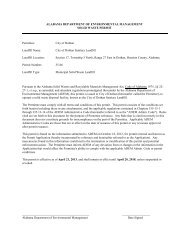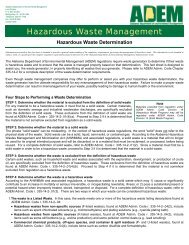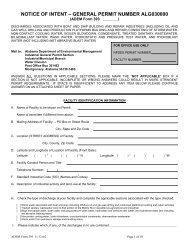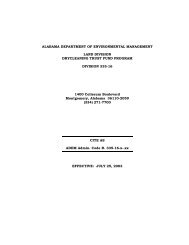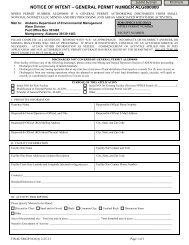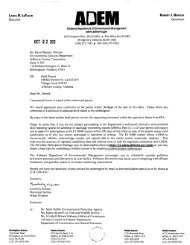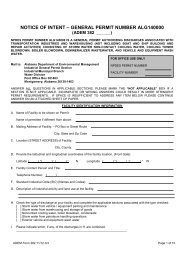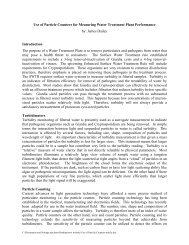drinking water branch fy2011 annual report - Alabama Department ...
drinking water branch fy2011 annual report - Alabama Department ...
drinking water branch fy2011 annual report - Alabama Department ...
You also want an ePaper? Increase the reach of your titles
YUMPU automatically turns print PDFs into web optimized ePapers that Google loves.
The majority of potential contaminant sites within the source <strong>water</strong> assessment areas have been<br />
given a “low susceptibility” ranking. The main reason for these low rankings is that many of the<br />
raw <strong>water</strong> sources were designated for <strong>drinking</strong> <strong>water</strong> at the time of construction, and therefore,<br />
use by the public has been controlled. The majority of potential contaminants stem from highway<br />
bridge crossings where vehicular traffic is high but the potential for a “contamination event” is<br />
low.<br />
Source Water Assessment (SWAP) – Ground<strong>water</strong> Sources<br />
All public <strong>water</strong> supply systems with ground <strong>water</strong> sources have completed a SWAP for each of<br />
their existing sources. All <strong>water</strong> systems are required to update their SWAPs when applying for<br />
reissuance of their permits-to-furnish <strong>water</strong>. All new ground<strong>water</strong> sources must have a<br />
completed SWAP, prior to using the source for potable <strong>water</strong>. A completed SWAP for a<br />
ground<strong>water</strong> source must include the following:<br />
• Delineation of the source <strong>water</strong> assessment area (SWAA),<br />
• An inventory of the possible contaminant sources within the SWAA,<br />
• A susceptibility analysis of each possible contaminant source in the inventory, and<br />
• A public awareness requirement<br />
When the SWAP requirements were initially promulgated, <strong>Alabama</strong> had a total of 414 public<br />
<strong>water</strong> supply systems that utilized one or more ground<strong>water</strong> sources. These systems were<br />
required to complete a SWAP for their ground<strong>water</strong> sources. The public <strong>water</strong> supply systems<br />
were categorized as follows:<br />
• 310 Community Ground<strong>water</strong> Systems<br />
• 75 Non-Community Transient Ground<strong>water</strong> Systems, and<br />
• 29 Non-Community Non-Transient Ground<strong>water</strong> Systems<br />
<strong>Alabama</strong> has received fifteen SWAPs for thirteen new or expanded ground<strong>water</strong> sources in<br />
FY2011. Eleven of these <strong>report</strong>s were submitted from existing public <strong>water</strong> systems and one<br />
<strong>report</strong> was submitted from a new public <strong>water</strong> system. SWAPs have been finalized for eight of<br />
the new well sources. For the remaining ground<strong>water</strong> source, the SWAP is currently in the<br />
process of being reviewed and finalized.<br />
Wellhead Protection Program<br />
The wellhead protection program is regulated through the Drinking Water regulations, but is<br />
administered by a staff member in ADEM’s Ground<strong>water</strong> Branch.<br />
Underground storage tanks (UST) are the greatest source of chemical contaminants in ground<br />
<strong>water</strong> in <strong>Alabama</strong>. Approximately 335 UST compliance inspections were completed within<br />
wellhead protection areas. Approximately 175 corrective action sites are located within<br />
wellhead protection areas.<br />
9



